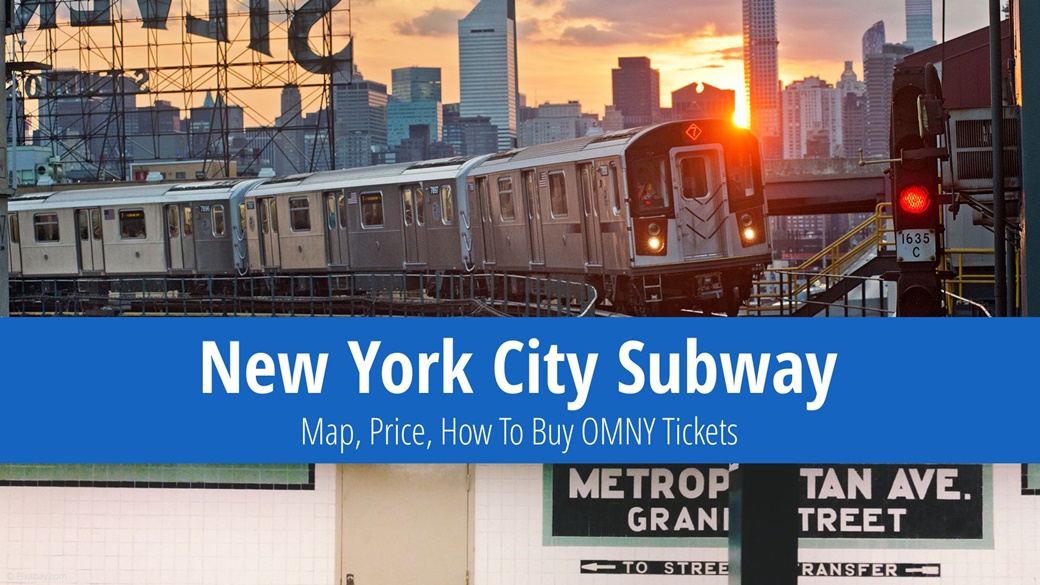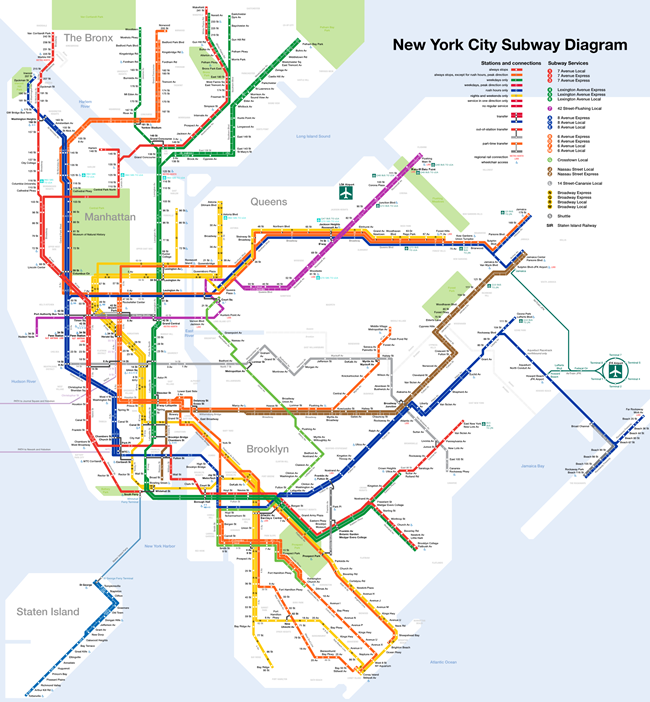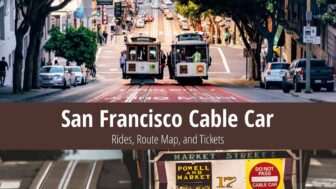The history of the New York subway dates back to October 27, 1904, when the first passengers were transported on the subway. As of January 2025, the New York City subway system had 472 stations, 28 lines, and carried an average of 5.15 million passengers per weekday. The New York City Subway is one of the few systems in the world that operate 24 hours a day, 365 days a year. There’s no need to worry about it. Simply pay your fare with a contactless card and use Google Maps to help you navigate.

-
Table of Contents
New York City Subway Fare 2025, Where to Buy Tickets
New York City subway tickets are sold single or prepaid for a specific time period. Tickets are valid for both the subway and local buses simultaneously. The New York City public transportation ticket prices have been updated as of January 2025.
💳 Pay by Card With Omny
The easiest way to pay is with your phone (Google Pay, Apple Pay) or with a contactless card that you just put on the turnstile. The display will immediately show you the payment status. The system is called OMNY, the ticket price is $2.90.
The free transfers remain with the OMNY system, you just need to always bring the same phone or card to the turnstile. Once $34 dollars have been spent within 7 days, all subsequent transfers are free. For reduced fares, a spending limit of $17.00 applies. However, you must still attach the card to the terminal.
The OMNY system is fully implemented on all subway lines and local buses. They will completely replace the outdated Metrocard during 2024.
🎫 Single Ticket
A regular ticket costs $3.25 and can only be purchased from ticket machines in metro stations. It is valid for 2 hours from the time of purchase and can be transferred between metro lines. However, it is not possible to change between metro and bus.
🔋 MetroCard Recharge Card
If you buy a MetroCard with $1.00, a regular ticket will only cost you $2.90.
📅 Weekly and Monthly Tickets
The MetroCard weekly and monthly passes are still available. If you ride public transport regularly, it is more convenient to pay by card through the OMNY system.
The weekly Unlimited Ride MetroCard is worth it if you use the Metro at least 13 times during the week. A 7-day pass costs $34, a 30-day pass costs $132 plus $1.00 for a new MetroCard. The weekly pass expires at midnight on the seventh day. MetroCards activated on Monday afternoon expire after 11:59 p.m. on Sunday.
🧒 Tickets for Children
Up to three children up to 112 cm can travel free with an adult passenger. Older children are ticketed as adults.
The MetroCard resembles a rechargeable card. It can be purchased for $1.00 at vending machines at stations and stops, in stores around town, or at an MTA kiosk. The MetroCard can be loaded with at least $5.50 of credit. You can pay with cash or a credit card. Swipe the card through the reader at the turnstile when entering the subway or bus.
- Detailed information on fares can be found on the transport company website
-
New York City Subway Map
To navigate the New York City subway, I recommend using the Google Maps mobile app, which searches for connections and displays departure times automatically. If you do not have data while in the city, download the entire area offline.
To do this, I recommend downloading the New York City subway map to your phone.
-
Subway Lines in New York City
The New York City subway system has 11 basic “lines” and 28 “services”. Line refers to the physical subway tracks (lines), each with its own color. Several lines (services) run on a single line and are identified by letters or numbers. Additionally, they are distinguished by:
- Express trains
Trains stop only at major stations, approximately every third to fifth station. - Local trains
Trains stop at all stations.
Listen carefully to the station announcements and pay attention to the displays on the sides of the trains. They show the line name and the name of the destination station. This will help you orient yourself; a common mistake is boarding an express train when you need to stop at one of the smaller stations.
Use the Google Maps app to easily find routes and transfer options. Simply enter your starting point and destination, and the app will also provide you with the nearest departure times. The New York City subway map is displayed at every station.
Line Name Quarters ⬤ 1 Broadway–Seventh Avenue Local Manhattan ⬤ 2 Seventh Avenue Express Manhattan, Brooklyn ⬤ 3 Seventh Avenue Express Manhattan, Brooklyn ⬤ 4 Lexington Avenue Express Bronx, Manhattan, Brooklyn ⬤ 5 Lexington Avenue Express Bronx, Manhattan, Brooklyn ⬤ 6 Lexington Avenue Local Bronx, Manhattan ⯁ 6 Pelham Bay Park Express Bronx, Manhattan ⯁ 7 Flushing Express Queens, Manhattan ⬤ 7 Flushing Local Queens, Manhattan ⬤ A Eight Avenue Express Manhattan, Brooklyn, Queens ⬤ B Sixth Avenue Express Bronx, Manhattan, Brooklyn ⬤ C Eight Avenue Local Manhattan, Brooklyn ⬤ D Sixth Avenue Express Bronx, Manhattan, Brooklyn ⬤ E Eight Avenue Local Queens, Manhattan ⬤ F Queens Boulevard Express/Sixth Avenue Local Queens, Manhattan, Brooklyn ⯁ F Culver Express Queens, Manhattan, Brooklyn ⬤ G Brooklyn-Queens Crosstown Local Queens, Brooklyn ⬤ J Nassau Street Local Queens, Brooklyn, Manhattan ⬤ L 14th Street – Canarsie Local Manhattan, Brooklyn ⬤ M Queens Boulevard/Sixth Avenue Local Queens, Manhattan, Brooklyn ⬤ N Broadway Express Queens, Manhattan, Brooklyn ⬤ Q Second Avenue/Broadway Express/Brighton Local Queens, Manhattan, Brooklyn ⬤ R Broadway Local Queens, Manhattan, Brooklyn ⬤ S Franklin Avenue Shuttle Brooklyn ⬤ S Rockaway Park Shuttle Queens ⬤ S 42nd Street Shuttle Manhattan ⬤ W Broadway Local Queens, Brooklyn, Manhattan ⬤ Z Nassau Street Express Queens, Brooklyn, Manhattan - Express trains
-
How to Travel on the New York City Subway
🦺 Subway Safety
The New York City subway may be crowded and unpleasant, but it is relatively safe considering the number of passengers it serves. Just use common sense. Do not carry your wallets in back pockets, always zip your purses, and avoid wearing conspicuous jewelry. Pickpockets are common.
⌛ Operating Intervals
Trains run approximately every 2 to 5 minutes during peak hours. At night, intervals are longer, and trains usually run every 10 to 20 minutes.
↔️ Watch Your Direction of Travel
Some subway entrances serve only one direction. In this case, the sign will say Uptown (northbound) or Downtown (southbound). Always watch your direction of travel and pay close attention to the displays on the trains.
At some stations, you will need to make sure you have the correct entrance from the street so you don’t have to go through the underpass. In such cases, the sign at the entrance will read, for example, “Downtown & Brooklyn.”
🔘 How to Know Which Subway Stops Where
Stations on maps are marked with a dot:
● Only local trains stop at these stations.
○ Larger stations serve both local and express trains.👣 Walkways Between Stations
In particular, subway transfer stations often stretch across several streets. If you need to change from one line to another, you don’t have to climb to the surface. Use the pedestrian walkways, which are marked with black straight lines on the subway map.
🌙 Travelling by Metro at Night
Look out for the area marked with a yellow sign in the stations that says Off-Hours Waiting Area. It’s well lit, monitored by security cameras and equipped with a phone or panic button to call for help.
🟢 Colored Spheres at Subway Entrances
Near the subway entrance, look for the pillar with a colored sphere. A green light indicates stations open 24/7, while a red sphere means the station closes after dark.
📷 Taking Photos in the New York Subway
Cameras are allowed on the subway, tripods and flashes are prohibited.
-
Fun Facts About the New York City Subway
🚇 Largest Subway Station in New York City
From Times Square-42nd Street Station, you can access 13 different subway lines, the most of any New York City subway station.
👪 The Busiest Subway Station in New York City
All ten of the busiest subway stations are located in Manhattan. Times Square tops the list again, with 65,020,294 annual riders in 2019.
↕️ Lowest and Highest Stations
The deepest station is 191st Street on Line 1, where the platform is 174 ft underground. The highest station is Smith-Ninth at 27 feet above street level.
🍕 The Link Between Pizza and Ticket Price
The price of a subway ticket in New York City is roughly equivalent to the cost of a slice of pizza at a kiosk. If one becomes more expensive, usually the price of the other will soon rise as well.
🎫 Token Thieves
Between 1953 and 2003, metal tokens were used as tickets. Tokens were thrown into turnstiles, and thieves stole them by simply sucking them out with their mouths. The situation escalated to the point where police officers resorted to spraying chili into the turnstiles.
👻 New York Ghost Stations
There are nine unused stations in the entire New York City subway system. They are called ghost stations. The most beautiful of these is the abandoned City Hall Station on Line 6, which operated from 1904 to 1945. The others are Court Street (closed 1946), 18th Street (1948), Myrtle Avenue (1956), Sedgwick Ave (1958), 91st Street (1959), Worth Street (1962) and Dean Street (1995).
The Ninth 76th Street Station remains shrouded in mystery, as it has never seen a single train pass through it and is not plotted on any plans.
👼 Guardian Angels of the New York City Subway
In the 1970s, crime was rampant in the subway and the security situation got worse every year. On February 13, 1979, New York native Curtis Sliwa founded the Guardian Angels initiative. The Guardian Angels were a group of volunteers who wore red berets and white tank tops. Mostly young and muscular men, they rode the subway in their spare time and ensured security.
📺 Television Shows About the New York Subway
If you’re interested in the New York subway, check out the documentaries New York Subway, Dark Days, and Extreme Engineering.
For more information, visit the MTA website. Post your experiences with the New York City subway in the discussion.

 10 Best Photo Places in the USA
10 Best Photo Places in the USA





Contribute with Your Question or Personal Experience